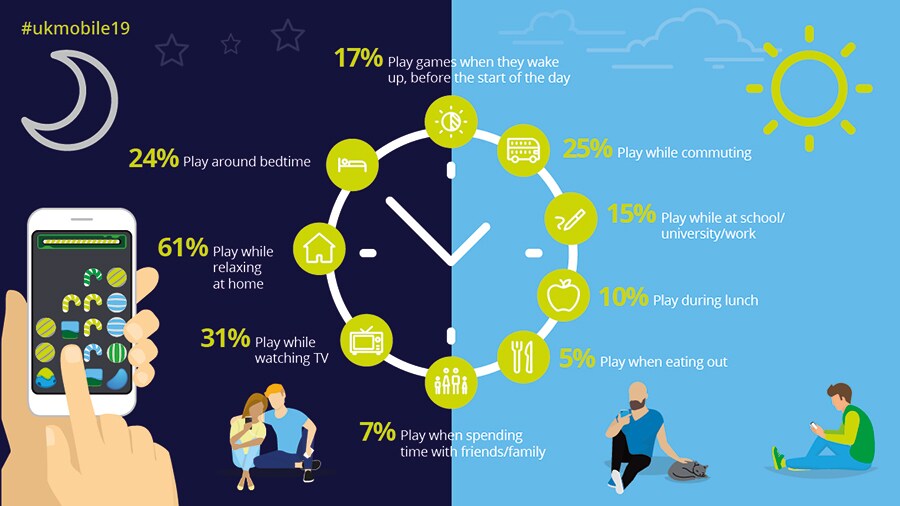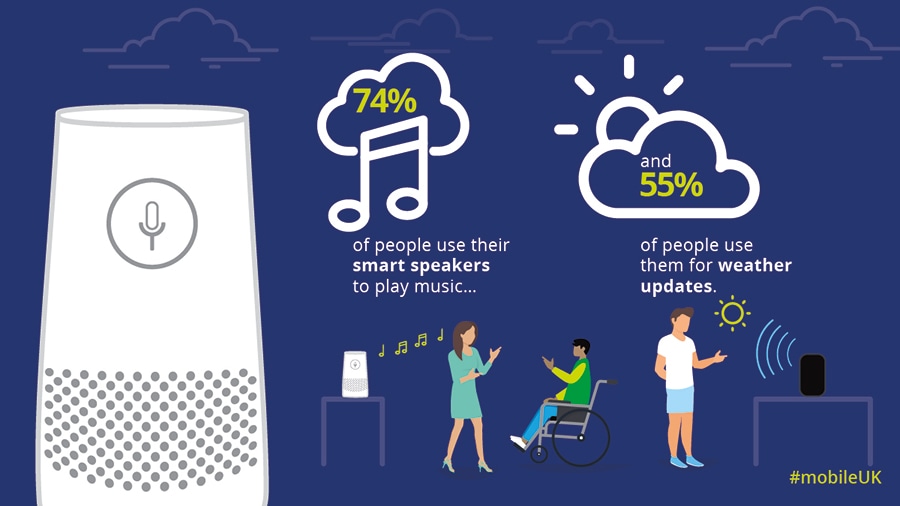Digital entertainment
Digital entertainment is multifaceted. Video on demand, social media, streaming services, online gambling – all are multi-billion-pound industries in their own right, and together they form a large part of why we’re so hooked to our phones.
So whether it’s streamed, downloaded, native or web-based, we’re all constantly watching, reading, listening to or playing content on our phones – and our consumption continues to rise.
Naturally, the trick is getting us to pay for it, and when we do have to dip into our pockets, we do so in a variety of ways: in-app purchases, consuming ads, subscription packages, etc.
Our survey found that 25% of mobile gamers play on their commute every day, while 17% play from the moment they wake up. Gaming is of course a major element of digital entertainment. The smartphone and tablet games market should top £1.2bn globally in 2019, and is growing at 20% a year. We estimate that the mobile phone’s share of that revenue will reach close to a billion pounds in 2019, compared to the equivalent forecast for console-based eSports at £0.9 billion.

All this gaming takes time, and Android users spent around 1.4bn hours playing mobile games last year – up 15% on the previous year. And it’s not just young smartphone gamers either – yes, they still make up the majority across the games field, but games such as Candy Crush have an older appeal, with most players being women over 35. In fact, for those casual games and word or board games, women outnumber men, but in every other category gaming is predominantly a man’s world. A missed opportunity?
So, what’s next? Games titles – both new and existing – are constantly expanding and evolving, enticing players to stay engaged; hardware improves year on year, with handset manufacturers competing to offer ever-more-powerful processors and brighter screens with higher refresh rates.
But that’s not news. The real story lies in subscription models and the spread of 5G. 5G is set to reduce latency and improve streaming speeds, which will appeal particularly to those playing massively multiplayer online games (MMOs). And for payment models, we expect to see more subscription-based gaming, with freemium to premium levels in single games, and a broad portfolio of games to choose from within packages priced to match or beat current gamer spend levels of £4 or £5 per month. Apple’s Arcade subscription service at £4.99/month is a recent example, and Google’s Play Pass is hot on its heels.
Beyond gaming, smartphone connectivity is enabling many other digital entertainment services to be enjoyed, including of course on-demand video. In fact, smartphone users are obtaining more and more of their digital entertainment content via their mobile device.
Of the digital media providers, Netflix leads the way, with a 43% market share for the segment and rising adoption by the 35-44 age band – up 10% year on year. This is a segment that will grow – albeit at a decreasing rate – and have an ever-closer relationship with the digital games market as subscription-based streaming platforms in that segment become the norm.
Another growing form of digital entertainment is the smart-speaker market, which has been bought to life through smartphones. Smart speakers have been a hot topic in the press this year, with negative stories making headlines. However, we don’t expect the negative stories to have too much impact on sales or usage – for the majority of consumers, price and utility will be much more significant factors. The more useful they are, the more they will be adopted, and the more they will be used.
The vitality of the mobile games and streaming markets is down to their variety: there’s something out there for everyone. Games can last seconds or evolve over months; new TV dramas can be binge-watched or consumed at our leisure. The dawning of the subscription age was the key driver for internet entertainment services, and may well also enable a new generation of games titles that do not rely on advertising or in-app payments to flourish. It’ll be interesting to see how the industry succeeds in ramping up the average monthly outlay.






